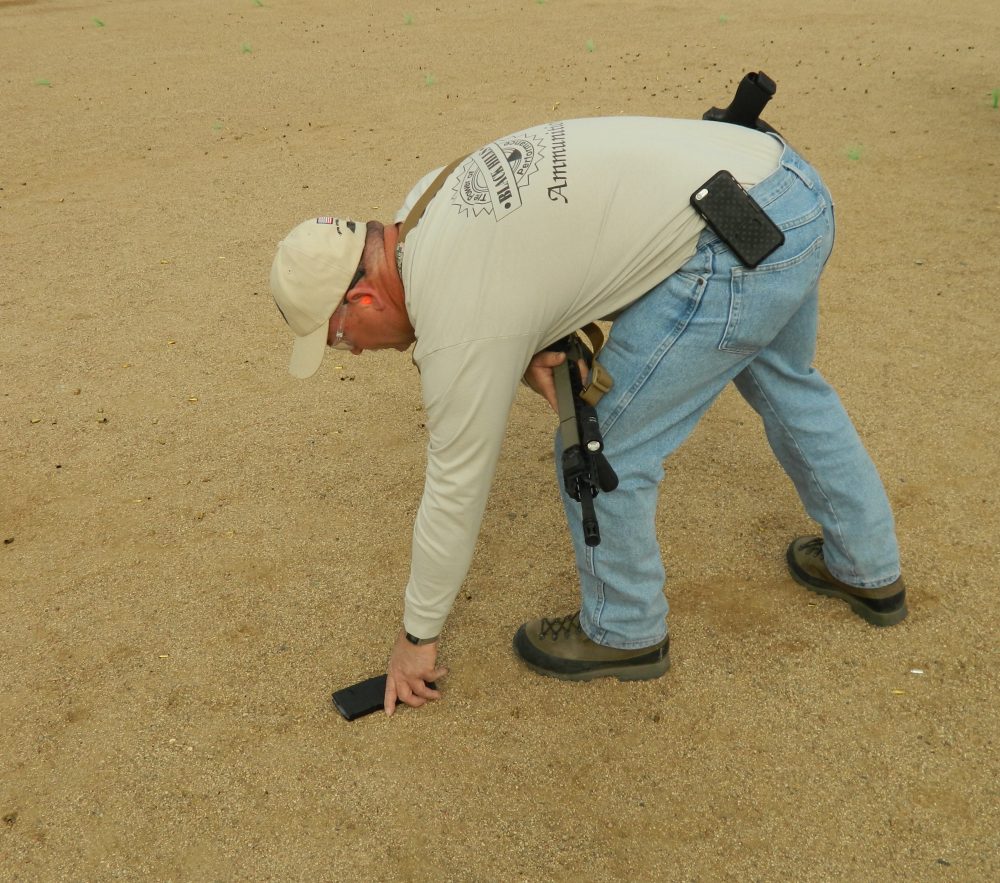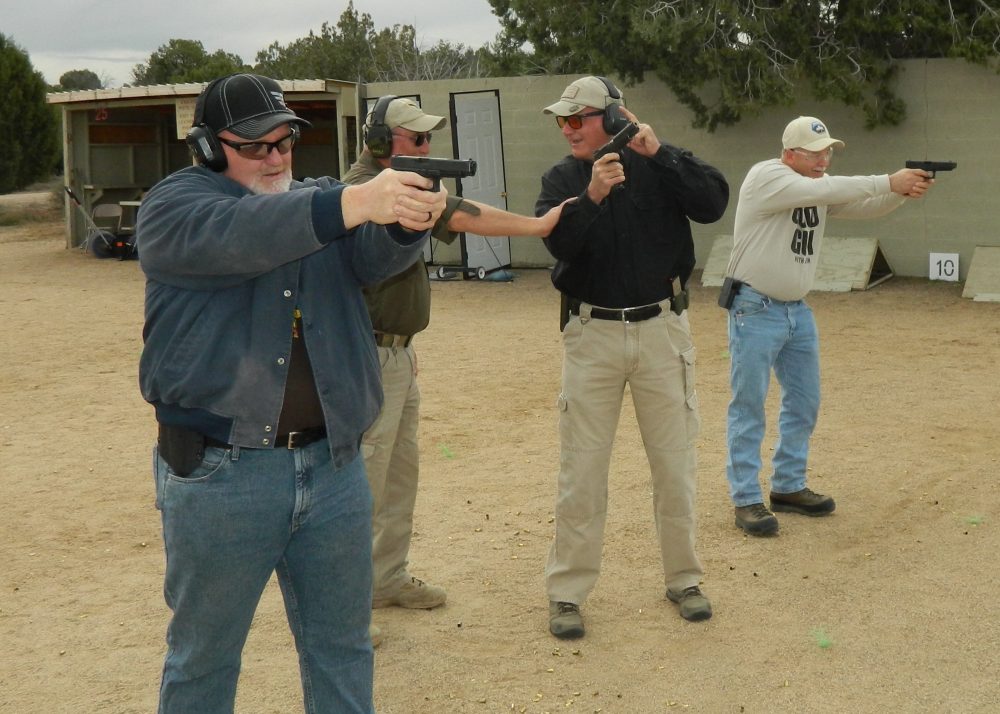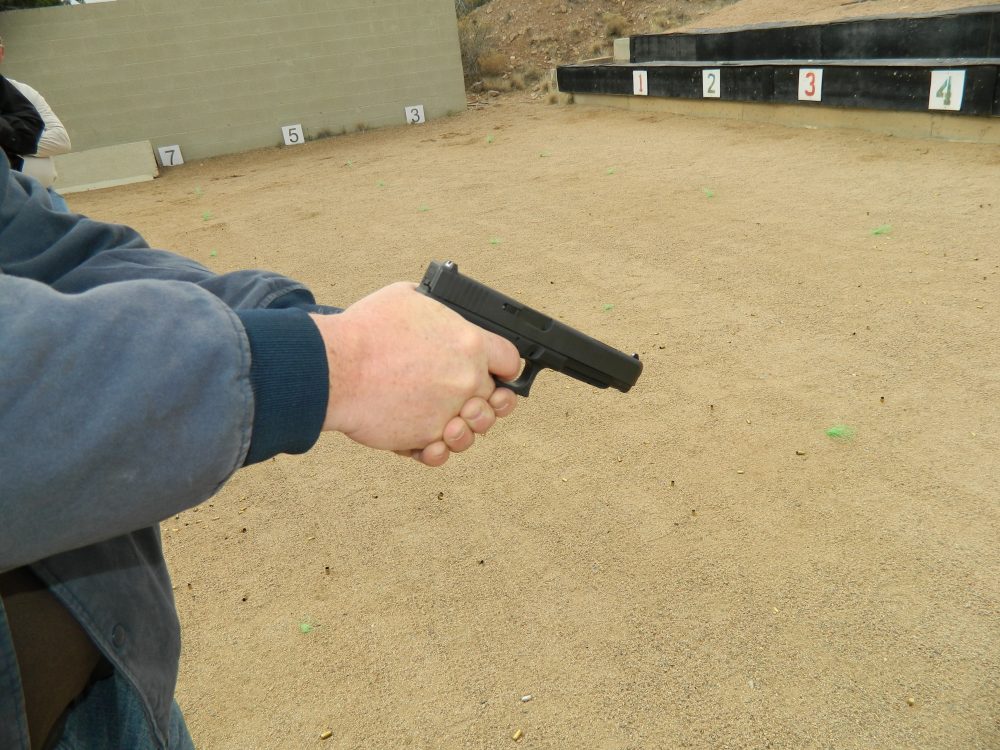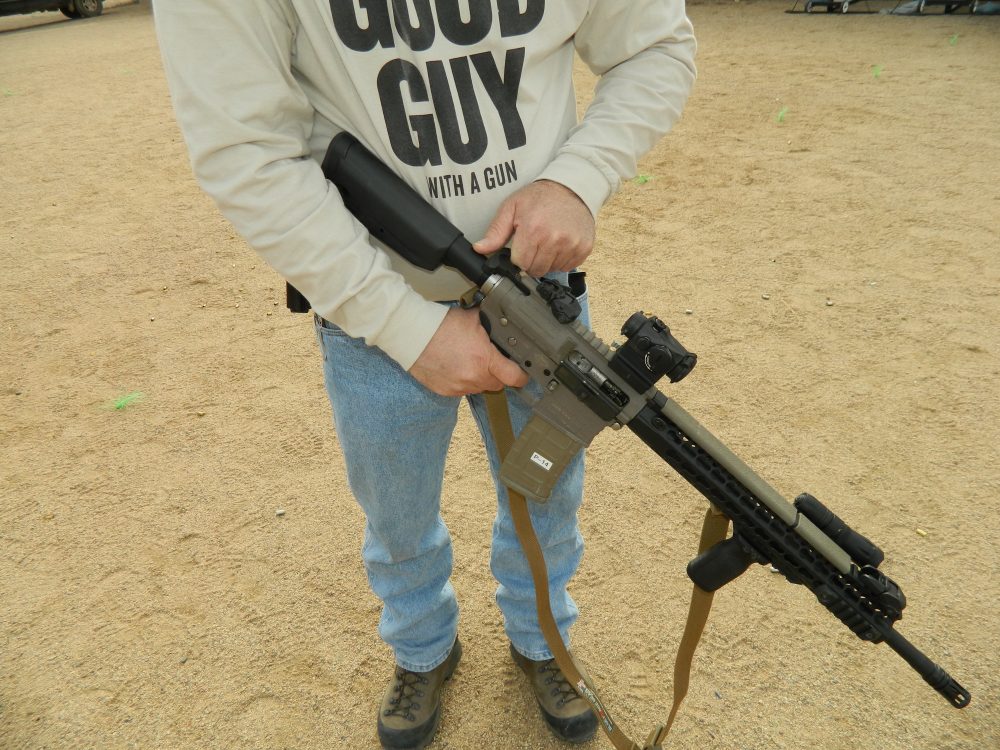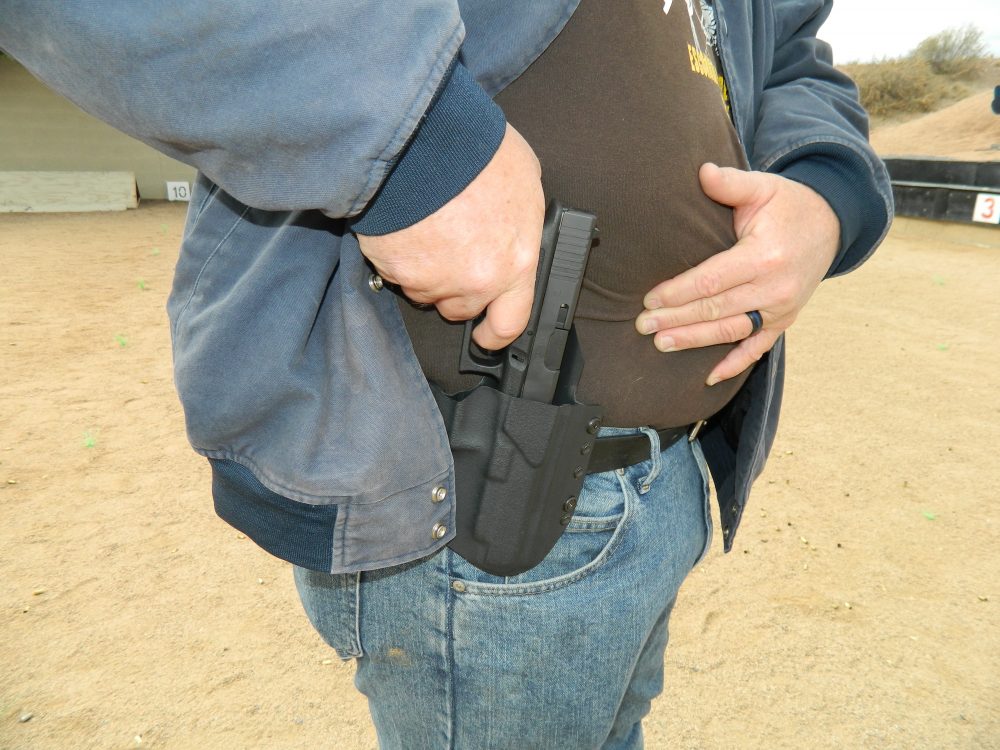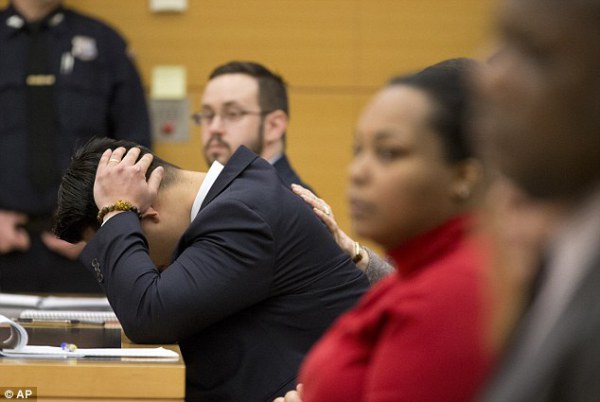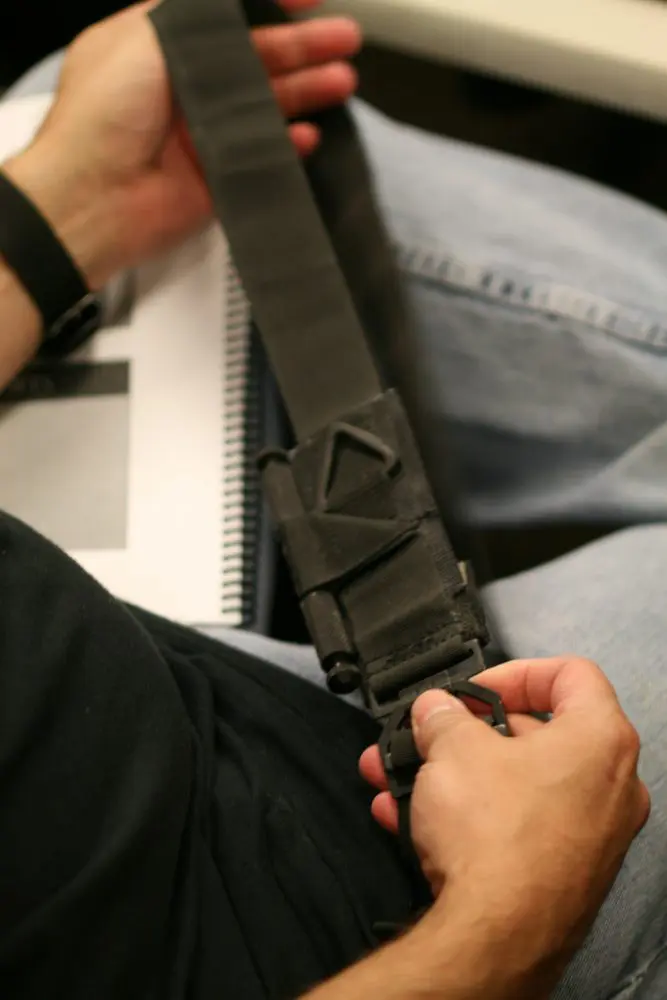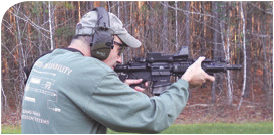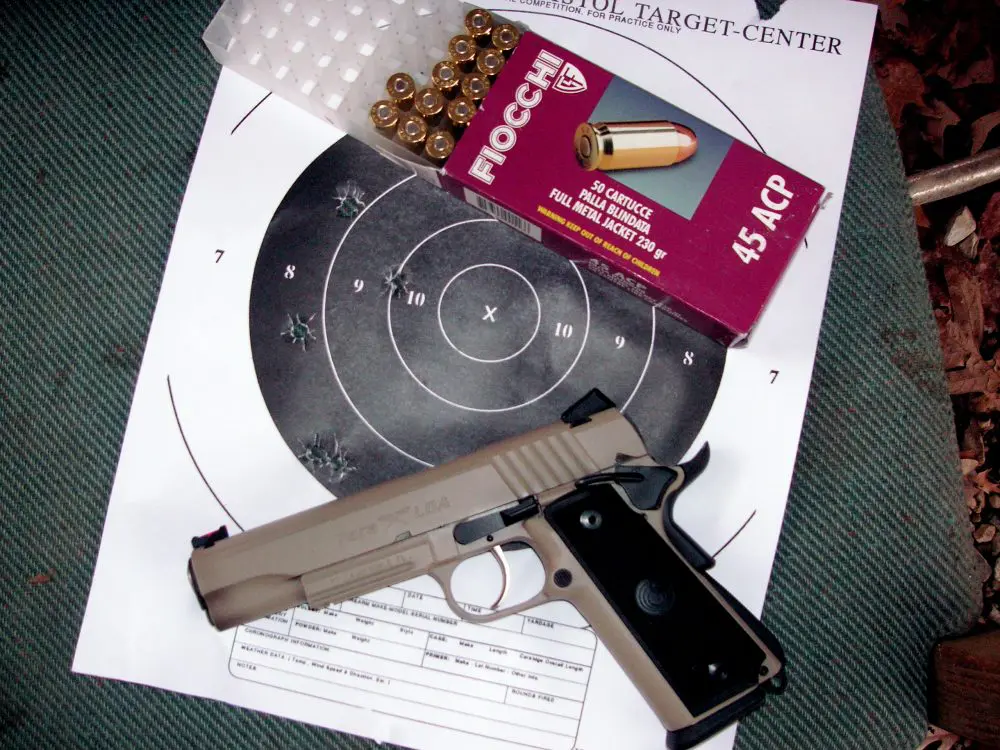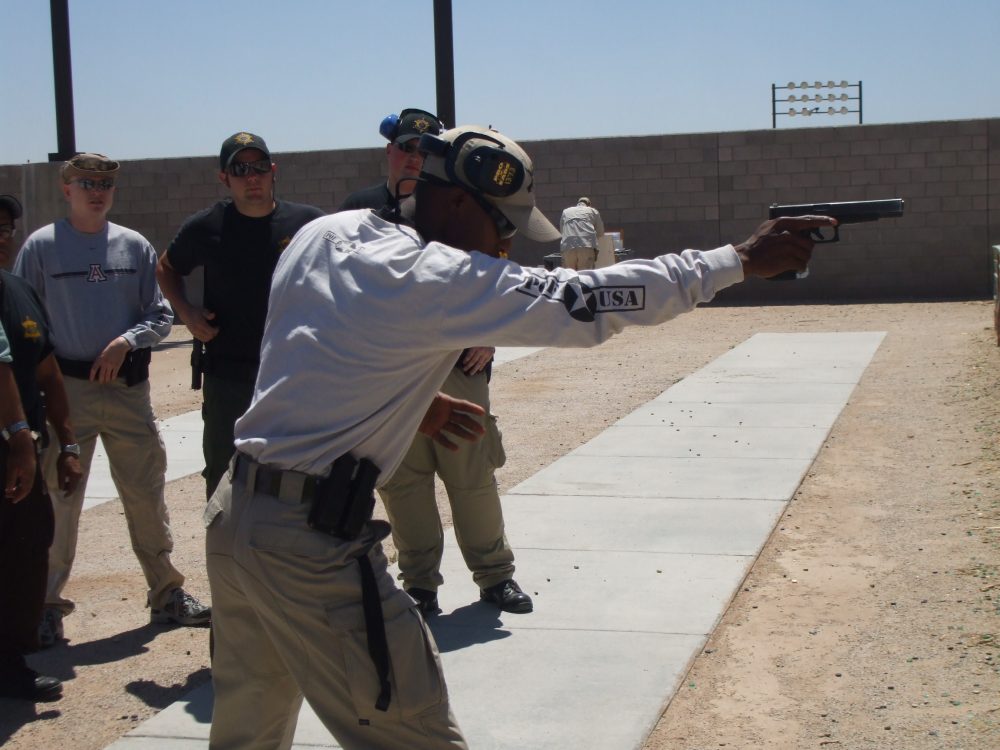With his finger on the trigger, student turns to ask range officer a question. Aware of this, RO places his hand on student’s arm before student can turn more.
Let’s start with some definitions. When a firearm is discharged, it is because it was discharged intentionally or unintentionally. There are no other options. How do we distinguish between the two?
An intentional discharge is when the human who has possession and control of the weapon willfully causes the weapon to discharge. Examples of this are when shooting a target at the range, or using the weapon in defense of your life.
An unintentional discharge of a firearm is when there is no willing act to discharge the weapon. An unintentional discharge may be negligent or accidental. In the former, it is caused by a human’s action. This is the most common cause of unintentional discharges, and it occurs because the human possessing the weapon does something that causes the firearm to discharge when it was not intended.
In the latter, it is because of a mechanical issue. An example of this is when Remington settled a class-action suit related to a potentially defective trigger on a certain model of their rifles. In this case, the rifle would allegedly discharge without the user pressing the trigger.
In either case, it is something to be avoided.
Thinking it will hasten taking a shot, shooter has his finger on the trigger while still in the “guard” position. In all likelihood, no one would be injured because he is pointing in a safe direction, but it is still a clear violation of Rule 3.
Table of Contents
FOUR SAFETY RULES
A long time ago, a wise man promulgated the Four Safety Rules. Strict adherence to them should be ingrained into the brain-housing group of anyone who possesses a firearm.
1. All guns are always loaded.
2. Never let the muzzle cover anything you are not willing to destroy.
3. Finger straight and outside the trigger guard until your sights are on target.
4. Be sure of your target. Consider the background.
Generally, violating one rule is not in and of itself a showstopper. Violating two of them can result in death or serious injury. Clearly Rule #3 is the rule that is violated most often and is the cause of almost 100% of negligent discharges.
We all understand that any unintentional discharge of a weapon is bad and should be avoided. We also understand—or at least we should understand—that perfection does not exist within our species. We are all fallible. We are all capable of losing our attention. Being tired. Being distracted. Being unaware. Being human. People have NDs for a variety of reasons, and primary among them is the fact that they lose focus. They forget why they are doing what they are doing.
Why does that occur? I’d like to say that for most, it is a lack of self-discipline and motivation, but I have seen enough NDs from mil guys from all branches and components to know that isn’t true.
Probably the greater percentage of NDs I have observed were because the offender was in poor physical and mental condition due to being out of shape, overweight, tired, dehydrated, or arrogant.

ANALOGIES
What are the aggravating factors? Probably the first is exposure to loaded firearms. Let’s draw an analogy or two. In 2012, there were an estimated 5,615,000 highway “accidents.” This does not include those that took place off highway (city streets or country roads), which may bring the total to 10 million or so.
These incidents are almost 100% of the time the result of negligence on the part of one or more people. And there are precious few of us who drive regularly who have not been involved in some type of motor vehicle incident. Why do you think that is? Maybe because we are in our motor vehicles pretty often?
U.S. DOT states that the average driver is behind the wheel 13,474 miles a year. That is a lot of potential for a motor vehicle incident. Think about how many cars you pass, or pass you, on your morning commute. Or how many you pass heading in the opposite direction.
Now think about how many drivers might be operating impaired—under the influence of drugs or alcohol. Or how many are texting, changing radio stations, entering addresses into the GPS, or thinking about the hot date they will later be meeting at the No-Tell Motel.
Scary, no?
Shooter charges his carbine with his finger on the trigger. What could go wrong?
How do you avoid being in a motor vehicle incident? Simple. Never get into a car. Never walk on a street or a road where traffic moves on. Or maybe limit your driving to that which is essential only.
Voilà!
How about commercial aviation? It is a pretty safe and efficient way to travel, but damn, when one of those big birds ceases controlled flight and makes unintentional contact with the ground, it’s pretty dramatic. Fire and bodies and pieces of bodies and dolls and clothing all over.
It will be breaking news on all the cable news channels for days or weeks, depending on how gruesome it is. How do we avoid dying in a commercial air crash? Again, simple. Don’t fly. Or if you do, only fly when absolutely essential.
Pretty rad, no?
Except that none of it is realistic. We assume risks in any endeavor and mercifully, the odds are in our favor. How does that apply to the shooting world? For a start, people who never touch a gun will never discharge one, intentionally or otherwise. But those who utilize firearms as a condition of their employment or use them for sport or defensive purposes handle loaded firearms on a regular basis.
Conversely, some collectors of weapons may handle firearms a lot but not ever shoot them. Of those who do use guns regularly, most have received minimal training, while some may have had extensive training.
Get the gun out quickly, put it away slowly. Only prize for “speed holstering” may be a trip to the emergency room. This photo was staged, but it happens all too frequently.
LEVELS OF ACHIEVEMENT
Here is a dilemma. Those with minimal gun-handling experience may perform certain tasks because they don’t know what to do or how to do it. This is the dreaded first level of achievement—Unconscious Incompetence. People at this level have a lot of NDs, mostly for a violation of Rule #3.
At some point, some of these people will seek knowledge and become better gun handlers, but will have to think about everything they are doing in order to keep from doing something stupid. This group falls into the next two levels of achievement: Conscious Incompetence, where they do something wrong but know it, and Conscious Competence, where they perform correctly but have to apply conscious effort in order to do so. The majority of shooters fall into one or the other of these two categories, and the majority of NDs occur here. As a sage once stated, they know just enough to be dangerous.
The last level of achievement is Unconscious Competence, the level at which one does not have to think about performing an act but does it without conscious thought. An analogy is when you get into your car. A lot of the functions you perform are at the level of Unconscious Competence. You sit in the seat, put on your seat belt, insert the key into the ignition, start the engine, adjust the temperature controls, check the mirrors and so on, all without conscious thought.
Why? Because you have performed these same functions thousands of times before. Once we start motoring down the highway, we know that before changing lanes, we look at the rear and side view mirrors, engage the turn signal, scan to ensure all is clear, and then ease into the other lane. Every time, right? Sure, every time until you don’t because you become lackadaisical and then wind up colliding with a vehicle you didn’t see.
It’s no different in the shooting world. People who handle guns day in and day out may know what they’re doing, but for one of a multitude of reasons fail to do something and as a result, have an ND. We have to fight the idea that because we handle firearms a lot, we will be immune from having an ND.
We also have to accept the facts that no one is perfect, and everyone is subject to having a moment when they are not functioning at high order. A friend once stated that “The only perfect man was nailed to a cross a long time ago.” I am not a religious person, but I understand the meaning.
While picking up a spent magazine from the deck, shooter fails to control his carbine’s muzzle.
HOW DO WE MINIMIZE OUR CHANCES OF HAVING AN ND?
Keep in shape. Eat properly and hydrate often. Those who fail the most do so because they cannot operate under pressure or when physical activity exceeds walking to the kitchen to get more Ho-Hos. Pay attention. Listen. Think. And if it does happen, own it. Learning points can be taken from every action, and if you can learn from your mistake, it will not likely happen again.
But not always. Some people are incapable of performing certain functions. Several years ago, I had a blivet in a class out West. He was always late. Always the last guy. Required 100% attention from an instructor 100% of the time. After the class ended and we were packing up, he had an ND into the ground while under the shed. He stated he had to “relax the spring on the striker.”
He was disarmed, counseled, and placed on my NFE list. A few months later, he went to a class taught by two very competent instructors. At the very beginning of the class, he had an ND under the shed! He was sent home, but a pattern was developing…
Shortly thereafter, he attempted to sign up for a class taught by another very competent instructor. Unfortunately for the blivet—but fortunately for everyone else—this instructor had heard of his previous incidents, called me to verify, and refused him admission. He was a serial negligent discharger and has no business ever being around other people with a loaded gun.
As gun owners—and users—we have a responsibility to act properly. Every negligent discharge has the potential to be newsworthy, and everything negative about a firearm or the user impacts all of us.
And if you ask me if I have ever had a negligent discharge, my answer will be an immediate “not yet.”
Pat Rogers is a retired Chief Warrant Officer of Marines and a retired NYPD Sergeant. Pat is the owner of E.A.G. Inc., which provides services to governmental organizations and private citizens. He can be reached at [email protected].
NYPD Officer Liang buries his head in his hands as he is convicted of manslaughter and official misconduct for a negligent discharge.
CONSEQUENCES OF NDs
Rookie NYPD Officer Peter Liang was convicted of manslaughter and official misconduct. Liang had a negligent discharge in the hallway of the Pink Houses, a crime-ridden city housing project in the East New York section of Brooklyn.
Liang was startled when the victim, Akai Gurley, opened the door to the stairwell in which Liang was patrolling. The officer negligently fired his Glock 19, the bullet struck a wall and then ricocheted into the victim’s chest.
Liang stated that his finger was never on the trigger and the gun “just went off.” Experts examined the gun, found it in working order, and that the gun had an 11.25-pound trigger pull. Each juror had the opportunity to handle the G19 and dry fire it.
NYPD is not known for its sophisticated firearms training, and how the Department utilizes Probationary Police Officers is questionable, but it is the individual’s responsibility to properly use his or her firearm.
Liang now faces up to a 15-year sentence in state prison.
